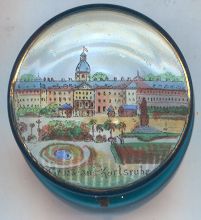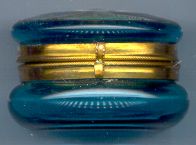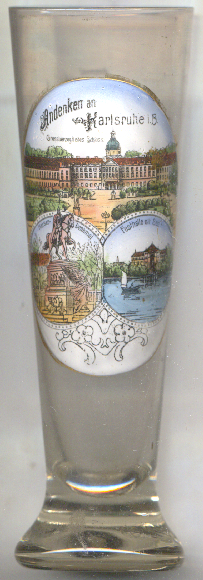

|
| DEUTSCHLAND | GERMANY |
| Bundesland: Baden-Württemberg | |
| Regierungsbezirk: Karlsruhe | |
| Stadt: Karlsruhe |
Karlsruhe is situated at an elevation of 118 m in Rhine rift on the rivers Alb and Pfinz between the river Rhine and the foothills of the Schwarzwald (Black Forest) and the Kraichgau. The independent city of Karlsruhe is the seat of the administrative region Karlsruhe and the district Karlsruhe. the city has a population of about 284,200 (2004).
Karlsruhe was founded in 1715 by Margrave Karl Wilhelm of Baden-Durlach. According to the legend, the margrave had fallen asleep during a hunting excursion in the vicinity of Durlach and had a dream: a splendid castle in the centre of a city with streets forming fans like the rays of the sun. It was this plan that was actually carried out when planning his new residence. The castle is loacted in the centre of a circle; streets spread southward in a fan-shaped manner through the city, fan-like alleys lead northward through the Hardtwald forest. From then on, Karlsruhe, named for its founder, was the residence of the margraviate Baden-Durlach, from 1806 the Grand Duchy of Baden.
In the last century several of the neighbouring communities including Durlach (1938), were incorporated into Karlsruhe, not always without opposition by their residents. After World War I, Karlsruhe was the capital of Germany's free state of Baden until 1945. After World War II, Karlsruhe at first became part of the federal state of Württemberg-Baden, consisting of the northern half of the former grand duchy and the northern half of Württemberg. Württemberg-Baden (capital Stuttgart), Baden (capital Freiburg im Breisgau) and Württemberg-Hohenzollern (capital Tübingen), were amalgamated to Germany's federal state of Baden-Würtemberg in 1952. In 1950, Karlsruhe became the seat of the Federal Court of Justice of Germany. The Federal Constitutional Court of Germany took its seat here in the following year.


The foundation in 1715 of the  Karlsruhe castle [left, no. 2028, and below, no. 4755: top picture]
also was the foundation of the city itself.
The original building was constructed partly of wood, which had to be replaced by a stone construction in 1746. Four years later,
the castle was remodeled after plans of Balthasar Neumann. The central tower was reduced in height in 1849 and at this occasion
received its characteristic dome-shaped roof. The castle was completely destroyed in 1944 and after the war was reconstructed
on an altered ground-plan to become the State Museum of Baden.
Karlsruhe castle [left, no. 2028, and below, no. 4755: top picture]
also was the foundation of the city itself.
The original building was constructed partly of wood, which had to be replaced by a stone construction in 1746. Four years later,
the castle was remodeled after plans of Balthasar Neumann. The central tower was reduced in height in 1849 and at this occasion
received its characteristic dome-shaped roof. The castle was completely destroyed in 1944 and after the war was reconstructed
on an altered ground-plan to become the State Museum of Baden.

The idea for the creation of a  monument for Emperor Wilhelm I [left, no. 4755: bottom left picture]
was already expressed by the Gfrand Duke of Baden in 1889, one year after the death of Gerany's first emperor. The monument was designed by the sculptor
Adolf Heer and was ceremoniously inaugurated on 18 October 1897. The bronze statue of the equestrian monument shows Wilhelm wearing the uniform of a
general, moungted on a three-tiered granite base. Until 1943, there was an allegorical figure on each side: in the east a figure Victoria, the the goddess
of victory, in the west Clio, the muse of historiography, in the north a lion and in the south a griffin. All figures were melted down in 1943 as part of
the metal delivery for World War II. On the north side of the pdestal there is a bronze relief depicting the proclamation of Wilhelm as German emperor in
Versailles. On the south side there is a depiction of Baden troops. In 2002, 27 granite plaques bearing the names of the revolutionaries who were executed
during the Baden Revolution of 1849 were embedded in the ground east of the monument.
monument for Emperor Wilhelm I [left, no. 4755: bottom left picture]
was already expressed by the Gfrand Duke of Baden in 1889, one year after the death of Gerany's first emperor. The monument was designed by the sculptor
Adolf Heer and was ceremoniously inaugurated on 18 October 1897. The bronze statue of the equestrian monument shows Wilhelm wearing the uniform of a
general, moungted on a three-tiered granite base. Until 1943, there was an allegorical figure on each side: in the east a figure Victoria, the the goddess
of victory, in the west Clio, the muse of historiography, in the north a lion and in the south a griffin. All figures were melted down in 1943 as part of
the metal delivery for World War II. On the north side of the pdestal there is a bronze relief depicting the proclamation of Wilhelm as German emperor in
Versailles. On the south side there is a depiction of Baden troops. In 2002, 27 granite plaques bearing the names of the revolutionaries who were executed
during the Baden Revolution of 1849 were embedded in the ground east of the monument.
The bottom right picture on glass no. 4755 shows a vire of the  Festhalle am See (Festival hall at the lake). The hall,
situated next to the Stadtgartensee (Municipal Park Lake) was designed by the architect Josef Durm and was inaugurated on 29 April 1877. The
representative building was used for festive events and concerts. At the beginning of the World War I, the Festhalle was equipped with 410 beds
for two weeks to serve as a makeshift hospital. The festival hall was badly damaged in World War II and the ruins were blown up in 1952.
Festhalle am See (Festival hall at the lake). The hall,
situated next to the Stadtgartensee (Municipal Park Lake) was designed by the architect Josef Durm and was inaugurated on 29 April 1877. The
representative building was used for festive events and concerts. At the beginning of the World War I, the Festhalle was equipped with 410 beds
for two weeks to serve as a makeshift hospital. The festival hall was badly damaged in World War II and the ruins were blown up in 1952.
[https://de.wikipedia.org/wiki/Karlsruhe, https://en.wikipedia.org/wiki/Karlsruhe;
https://de.wikipedia.org/wiki/Kaiser-Wilhelm-I.-Denkmal_(Karlsruhe);
https://ka.stadtwiki.net/Festhalle_(historisch)]
![[scale]](lineal.jpg)